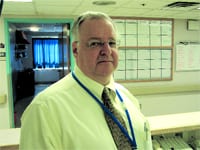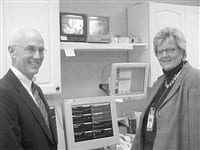Jim Clifford describes the Farren Care Center as a “safety net” for a challenging constituency.
It’s called ‘specialized long-term care.’
That’s an industry term, and maybe the most expeditious way to categorize the services provided at the 122-bed Farren Care Center (FCC) in Turners Falls. But the phrase doesn’t begin to describe what goes on inside the walls of this former acute-care hospital built more than century ago — and often outside them, as well.
To become a resident at what is often referred to as simply ‘the Farren,’ individuals must have been rejected for admission at no fewer than five traditional nursing homes. Most have been turned down by a multiple of that number, and Jim Clifford, administrator at FCC, recalls one man who was rejected by 75 such facilities before he eventually came to his new home on Montague City Road.
The ‘nos’ from traditional care centers are prompted by dual diagnoses, or combinations of needs that Clifford describes as ‘me, me’ — meaning medical and mental, or psychological — and an inability to adequately meet them. Specific conditions vary with each individual, he explained, but the common denominator is that the sum of their problems places their care requirements into the realm of the extraordinary.
And with the phasing out of mental-health facilities such as Northampton State Hospital and Belchertown State School nearly two decades ago, the Sisters of Providence Health System recognized a need to serve this challenged and challenging constituency, and responded by creating a truly unique care center at the site of the former Farren Memorial Hospital.
There, dedicated, specially trained staff members work to provide a better quality of life for residents ages 30 to 90, but often, the caring doesn’t stop when a life is over.
Indeed, there are many spaces in St. Anne’s Cemetery in Turners Falls that have been set aside for residents of the Farren. The facility, through various funding mechanisms and partnerships, ensures that individuals who have no family to speak of — and many at FCC fall into this category — are given proper funeral services and burial.
For most residents — that’s the term staff members prefer over patients or clients — the Farren will indeed be their last address, because no other facility can fulfill their needs, and their condition will not improve to the extent that they can live in another setting.
But some, perhaps 10{06cf2b9696b159f874511d23dbc893eb1ac83014175ed30550cfff22781411e5} and a number that is trending upward by some accounts, will be discharged to a group home or perhaps even their own apartment because they have improved.
‘Michele’ is one such individual. She told The Healthcare News that she has very much enjoyed her stay at Farren, which she described as much better than any of the many traditional nursing homes she’s been in, but is nonetheless looking forward to the day, probably weeks or a few months away, when it will end.
“And I hope it will be permanent,” she said of her pending relocation to a group home in the Boston area, knowing that many who are discharged eventually return to FCC. “It’s going to be hard for me at first, but I’m going to be ready, and work hard so I don’t have to come back.”
In this issue, The Healthcare News goes inside a little-known, often misunderstood health care facility to examine not only the specialized variety of care provided there, but how it is provided.
Starting Points
As she talked about FCC and its mission, Anne Nusbaum, its director of Nursing, got right to the larger point.
“We take these people who are so difficult, and we change their lives around,” she said rather emphatically. “We give them a quality of life they’ve either never had or haven’t had for many years.”
Elaborating, Nusbaum said staff members at FCC give residents a fresh start — “we don’t care what these people have done before” — and then help them make the most of it, by providing some things that many residents hadn’t seen much, if at all, before arriving at the facility.
These include such tangibles and intangibles as an extended family (in this case, the staff and other residents), some positive reinforcement, and activities, such as gardening, parlor games, or van trips into the community, that fill their time — and their lives.
It’s been this way since Farren Memorial, opened in 1899 in a broad act of philanthropy on the part of construction company owner Bernard Farren, was transitioned into specialty long-term care nearly two decades ago.
Tracing the history of the facility, Clifford said that a changing competitive landscape eventually doomed Farren as an acute-care hospital, and that by the mid-’80s, the SPHS had began exploring alternative roles for the four-story complex that would help the system fulfill its mission — specifically to meet the needs of generally underserved segments of the population.
Eventually, the system focused on specialized long-term care, a need exacerbated by the mainstreaming of mentally disabled individuals by the closing of Northampton State Hospital and similar facilities across the state. An extensive licensing process ensued, said Clifford, and the Farren eventually opened its doors in 1990.
It is the only facility of its kind in the state and one of the few in the Northeast, he continued, noting that referrals come from across the Commonwealth and New England, and sometimes well beyond. There is an extensive waiting list that ensures nearly 100{06cf2b9696b159f874511d23dbc893eb1ac83014175ed30550cfff22781411e5} occupancy.
Residents who meet that rather stern entry requirement — being rejected by at least five traditional nursing homes — have a variety of medical and psychological conditions that are bound by the adjective ‘extreme.’
“These people aren’t criminally insane; they just have behaviors that make it hard to treat them elsewhere,” said Clifford, who used the term “safety net” to describe Farren and its purpose.
These behaviors vary, and include schizophrenia, obsessive-compulsive disorders, aggressiveness, and other maladies that go well beyond dementia.
From a care perspective, the facility was designed to provide each resident with a level of dignity, said Nusbaum, while treating combinations of conditions that are beyond the scope of most other long-term care facilities.
Meanwhile, from a practical perspective, FCC helps dual-diagnosis individuals stay out of acute-care hospitals, where care would be much more expensive than it is at Farren — and draining on an already overburdened system.
“One of the stated goals for this facility when they created it was to prevent or reduce hospitalizations,” Clifford said. “A lot of these people lived in community settings of one sort or another, and were constantly in and out of the hospital for exacerbation of their psychiatric behaviors.”
Such problems would often prevent them from being returned to the community, he said, before and until their condition was stabilized, which is one of Farren’s primary reasons for being.
Life-and-death Decisions
When asked how the Farren goes about providing that quality of life, that dignity in life and death that he and others continually referenced, Clifford said it comes down to compassion and a broad team approach to providing care.
And while each case is different, there is what Clifford described as a “nuts-and-bolts” approach to creating care plans, or strategies, for individuals.
It starts with an overall assessment that begins long before a resident actually arrives at FCC, he said, noting that extensive reviews, which include face-to-face evaluations, are carried out by the facility’s admissions director, the nurse manager for the unit the individual in question will live in, and other staff members.
The assessment process continues after a resident arrives, he said, noting that a nurse manager, nurses, certified nurse assistants (CNAs), social workers, and others are all involved in putting together a care plan. The overall process — assessing an individual, identifying problems and issues, developing a care plan, implementing the plan, and continually re-evaluating the resident — is similar to that found in traditional long-term care facilities, “with the difference being the nature and scope of the interventions needed to stabilize these individuals,” he said.
In such an environment, some residents thrive and improve to the point where they are ready to be discharged, said Nusbaum, who cited ‘Michele’ as one of several comparatively younger residents who have re-entered the community, or soon will if their progress continues as expected.
While such discharges are still somewhat rare, they are the stated goal, especially for younger residents, she explained. “When someone comes here in their 30s or 40s, we don’t want them to spend the rest of their life at Farren.”
‘Michele’ will be returning to the Boston area and a group home there “soon” — that was her word — and gave credit to staff members who helped stabilize her condition and enable her to find new levels of independence.
She had high praise for one of the foundations of care at Farren — its so-called milieu program, or package of activities staged between 7 a.m. and 7:30 p.m. every day. The concept of activities is common to all long-term care facilities, said Nusbaum, but owing to the severity and complexity of medical and psychological conditions prevalent among residents, staff members must be especially creative in this realm.
“Customize” was the word she used to describe how programs are tailored for individual units or specific residents.
As an example, she referenced a clambake, staged last year, that was crafted so that even residents with swallowing disorders — and there are many of them — could partake and enjoy the festivities. Other activities include gardening — Farren has extensive facilities, all at wheelchair height to enable all residents to take part — and also parlor games, excursions off site for ice cream or apple picking, for example, and an annual strawberry festival,
And some activities don’t fall neatly into the traditional daily schedule, said Nusbaum, noting a recent meteor shower that occurred around 2 a.m. Some staff members not on duty at that time actually came in to work at that hour to help take residents outside so they could get a glimpse of the rare occurrence.
Such efforts on behalf of the staff help provide a sense of involvement that has been missing from the lives of many residents, she continued, adding that it extends to the last days of one’s life — and even beyond.
Some of the patients have outlived family members or are alienated from family, Nusbaum explained, adding that when these individuals approach the end, there is no one to be with them for their final days or hours, and when they die, there’s no one to make arrangements and bid farewell.
Farren staff members fill in under both circumstances, continuing that sense of community.
“No one dies alone here,” she said, adding that staff members often volunteer their own time to be with residents at the end. When residents pass on, FCC staff members stage memorial services on site, and those without family or for whom no arrangements have been made — more than 25 since the program started in 2002 — are buried in St. Anne’s, with their own grave marker.
“It’s a very unique program,” Clifford said of the burial service, carried out with the help of a local church and funeral home. “We carry that sense of involvement beyond the grave.”
Care Package
Even for those who are never discharged from FCC, there is a better quality of life than what existed before they arrived, said Nusbaum.
She told The Healthcare News that she’ll often hear staff members at traditional nursing homes say of individuals who eventually wind up at Farren, “that person was really a challenge!”
“Well, we love people like that here,” she continued, adding that such an attitude makes FCC special, and uniquely qualified to change such lives around.



Comments are closed.